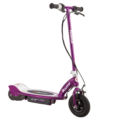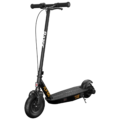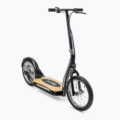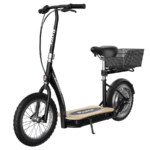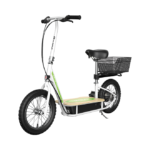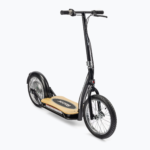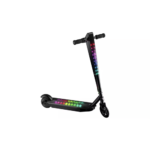- Home
- Scooters
- Electric Scooters
- Razor EcoSmart Metro HD
Razor EcoSmart Metro HD
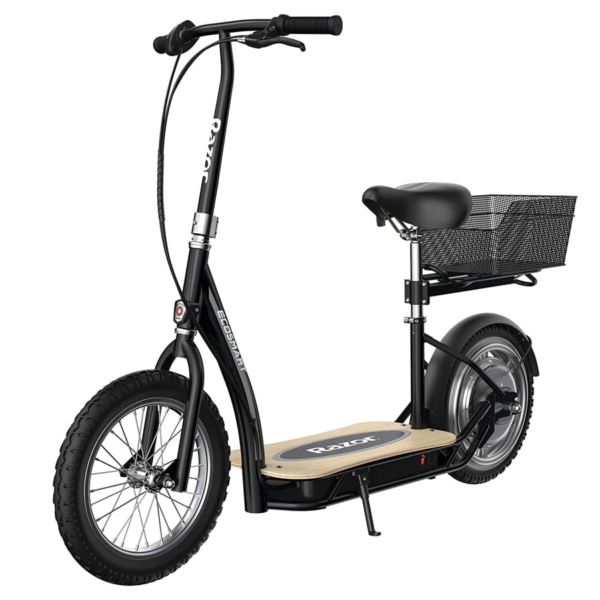
- Battery Range: 12–15 mi (19–24 km)
- Top Speed: 18 mph (29 km/h)
- Motor Power: 500 W nominal (hub drive)
- Weight Capacity: 220 lb (100 kg)
- Charging Time: ~6–7 h
- Scooter Weight: 66.0 lb (29.9 kg)
PROS
- Quiet high-torque hub motor
- Seated comfort + bamboo deck
- 16″ pneumatics for compliance
- Rack/basket friendly design
- Low-maintenance drivetrain
CONS
- Heavier to carry upstairs
- Pneumatic tires need checks
- Large storage footprint
- Range dips in cold/headwinds
Table of contents
- What Is the Razor EcoSmart Metro HD?
- How the Razor EcoSmart Metro HD Works
- Key Specifications
- Design & Build Quality
- Performance Fundamentals
- Battery, Range & Efficiency
- Ride Quality & Comfort
- Braking & Safety Features
- Portability & Daily Usability
- Maintenance & Care
- Weather & Seasonal Considerations
- Razor EcoSmart Metro HD vs Alternatives
- Who the Razor EcoSmart Metro HD Is (and Isn’t) For
- FAQs
- Glossary
- Final Thoughts
The Razor EcoSmart Metro HD is a seated, large-wheel electric scooter built to be simple, sturdy, and practical. It mixes a comfortable riding position with bicycle-like wheels and a rear hub motor, so neighborhood trips and short commutes feel easy rather than rushed. Because it favors reliability over flash, it suits new riders, casual errand-runners, and anyone who wants a calm, predictable ride without steep learning curves.
What Is the Razor EcoSmart Metro HD?
At its core, the Razor EcoSmart Metro HD is a sit-down personal electric vehicle with a steel frame, a wide bamboo deck, and 16-inch pneumatic tires. Instead of the narrow stance of many standing kick scooters, it offers a stable, bench-like posture with a padded seat and relaxed cockpit. As a result, riders who dislike standing for long periods—or who want a steadier feeling on bumpy neighborhood streets—tend to prefer this format.
Unlike compact commuter scooters that fold tightly for briefcase-style carrying, this model leans into “simple to use, easy to maintain, and comfortable to ride.” The hub-driven rear motor removes chains and sprockets from the equation, which reduces noise and day-to-day tinkering. Additionally, its hand-operated rear brake and twist-throttle controls feel familiar to anyone who has ridden a simple bicycle or moped-style e-ride.
How the Razor EcoSmart Metro HD Works
Motor and controller. The rear wheel hides a brushless hub motor that delivers steady torque without the whirring chain noise you hear on older belt- or chain-drive designs. The electronic controller meters power based on throttle input and battery state, so starts feel smooth rather than jerky. Because power arrives in a linear way, most riders get the hang of it within minutes.
Battery. A 36-volt lead-acid battery pack supplies the motor. Lead-acid technology is heavier than lithium, yet it remains straightforward, proven, and budget-friendly. While it doesn’t love deep discharges, it delivers dependable energy when you keep it topped up and stored properly.
Throttle. A twist-grip throttle on the handlebar commands speed just like a basic scooter or moped. Turn gently for slow starts and a quiet roll-off; twist more for brisk neighborhood pacing. Since the throttle is analog, small inputs produce small changes, which helps new riders modulate speed with confidence.
Brakes. A hand-operated rear brake provides stopping power. Mechanical systems require occasional cable inspection and pad adjustment, but they are transparent to maintain and easy to understand. Squeeze the lever, feel the bite, and scrub speed predictably.
Putting it together. The result is a calm, seated ride that emphasizes balance and visibility. Large, air-filled tires absorb small cracks and driveway lips. Meanwhile, the seat and bamboo deck provide room to adjust posture mid-ride.
Key Specifications
The table below groups the most relevant details for quick reference. You can skim it to see the most important specifications without digging through the full article.
| Block | Details |
|---|---|
| General | Seated electric scooter with steel frame and wide bamboo deck; 16-inch pneumatic tires; rear-hub motor; padded seat; kickstand; basket/luggage rack on many packages. |
| Performance & Power | Brushless rear-hub motor tuned for neighborhood speeds; steady acceleration; rear-wheel drive for planted starts on gentle grades. |
| Battery, Charging & Electrical | 36-volt sealed lead-acid battery pack; standard home-outlet charger; best longevity when stored charged; basic handlebar charge indicator. |
| Build & Dimensions | Large-wheel footprint closer to a small bike than a compact kick scooter; non-folding main frame; seat post removable for storage; folded dimensions: not applicable (frame does not fold). |
| Safety & Control | Hand-operated rear brake; twist-throttle control; reflectors; headlight/taillight packages vary by bundle; large tires for stability and bump absorption. |
| Features & Extras | Padded seat, wide bamboo deck, rear cargo basket/rack on many trims; tool-serviceable brake and cables; Cruise Control: not provided on typical packages. |
| Warranty & Compliance | Limited warranty; coverage varies by region. Follow local rules for low-speed electric devices; always wear a helmet and high-visibility gear. |
Design & Build Quality
Frame and deck. The frame uses tubular steel, which prioritizes durability and a planted ride feel. While aluminum can shave weight, steel’s resilience is welcome on a seated scooter that may carry groceries or a backpack. The bamboo deck is wide and flat, so your feet can sit side by side. Because it’s broad, you can shift foot positions to reduce fatigue on longer rolls.
Stem and cockpit layout. The handlebar area resembles a simple bicycle cockpit. You get a twist-throttle on the right and a brake lever that mirrors standard bike ergonomics. The layout is uncluttered, which reduces distraction and makes “look-where-you-want-to-go” riding easier. Grips are soft and slightly tacky, so your hands stay relaxed.
Fit and finish. Paint coverage is even and practical. Fasteners are accessible with common tools. The seat uses supportive padding with a shape that favors upright posture. Because the scooter sits higher than compact stand-up models, it provides a good view in traffic, especially on neighborhood streets.
Durability choices. While some riders chase ultralight carbon bits, this scooter leans on proven components that can handle daily use. As a result, it feels built for errands, short commutes, and weekend loops—tasks where quiet, reliable performance matters more than shaving every pound.
Performance Fundamentals
Acceleration feel. Starts are measured rather than explosive. That’s ideal for new riders, shared yard paths, or crowded bike lanes. Twist steadily and the scooter glides forward without lurching. Because the motor is in the rear hub, traction is predictable and easy to trust, particularly on clean pavement.
Cruising stability. The 16-inch pneumatic tires do a lot of work here. Larger diameter wheels roll over cracks and driveway lips with less drama than small scooter tires. Consequently, the cockpit stays calmer, and the seat remains a comfortable place to sit. At neighborhood speeds, the steering feels neutral and settled.
Hill-climb behavior (~7–10% grades). On moderate residential slopes, plan for a sit-and-steady approach. With a seated scooter and a hub motor, momentum is your friend. Start the climb with a little roll-in speed. Then hold a constant throttle. On steeper ramps, the scooter slows, yet it keeps chipping away if you maintain balance and avoid sudden throttle chops. For frequent hills, keep tires at the right pressure and avoid carrying unnecessary extra weight.
Battery, Range & Efficiency
Rated vs. real-world range. Like any small electric vehicle, actual range depends on the rider, the route, and the weather. A lighter rider cruising at modest speed on smooth, flat pavement will extract more distance than a heavier rider tackling rolling streets and stop-and-go traffic. Because the scooter uses lead-acid chemistry, it also appreciates moderate ambient temperatures.
What affects range the most?
- Rider weight and cargo. More mass means more energy to accelerate and to climb.
- Terrain and surface. Hills and rough pavement eat energy faster than flat, clean paths.
- Speed and starts. Sustained near-top-speed riding and repeated hard launches reduce distance.
- Temperature. Very cold or very hot days reduce effective battery output. Mid-range temperatures are best.
- Tire pressure. Underinflated tires increase rolling resistance; correct pressure helps efficiency.
Charging best practices. Because lead-acid batteries prefer being topped up, plug in after each ride if you’ve used a meaningful portion of the pack. Avoid storing empty. If you plan to leave the scooter idle for weeks, give it a full charge, then top off periodically so the pack doesn’t drift down. Additionally, keep the charger and battery away from extreme heat or freezing conditions. These basic habits noticeably improve longevity.
Efficiency tips you can feel. Ride at a steady, moderate pace; avoid tailgating; and look farther ahead so you can coast early instead of braking late. Furthermore, plan routes that favor smoother surfaces and gentle grades. Small planning tweaks often translate into an extra few blocks of range.
Ride Quality & Comfort
Tire type. The EcoSmart Metro HD rides on 16-inch air-filled tires with inner tubes. Pneumatics offer real cushioning and grip compared to solid rubber. Therefore, they calm chip-seal vibration and help the scooter track straight through shallow potholes. Keep pressures within the recommended window: lower pressures add comfort but can increase pinch-flat risk; higher pressures roll farther but pass more buzz to the seat.
Suspension and flex. This scooter relies on tire air volume rather than a dedicated fork or shock. Nonetheless, the big wheels and seat post deliver a forgiving ride if you scan for hazards and unweight slightly over sharp edges. Stem flex is low at neighborhood speeds because the bars are short and braced by a simple, sturdy clamp.
Ergonomics. The seated posture helps new riders relax their shoulders and look farther ahead. On longer rides, shift foot position on the bamboo deck every few minutes to keep calves and hips fresh. If your knees feel cramped, slide slightly rearward on the seat for extra room.
Braking & Safety Features
Braking system. A hand-operated mechanical rear brake manages most stops. The feel is linear: initial squeeze brings a light scrub, and deeper pull adds firmness. Because weight shifts forward during braking, keep your arms soft and your eyes level with the horizon. On wet pavement, extend stopping distance and feather the lever so the rear tire maintains grip.
Lighting and reflectors. Equipment packages vary, yet many units include reflectors and a basic light set. You can supplement visibility with a bright helmet light or reflective vest. Most importantly, ride as if you’re invisible: make eye contact at intersections, signal early with your arms, and leave extra space around parked cars.
Ingress protection. There’s no formal IP rating published for this model. Therefore, ride conservatively around puddles and avoid heavy rain. Water and electronics don’t mix, and lead-acid packs dislike deep soaking or long-term damp storage.
General safety. Wear a helmet. Add gloves for better lever control. Because seated scooters can invite one-handed riding, keep both hands on the grips and scan for road seams, driveway lips, and storm grates.
Portability & Daily Usability
Weight and carrying. This is not a featherweight kick scooter you sling over a shoulder. It’s closer to a compact bike. As a result, think “roll it, don’t carry it.” Parking in a garage, bike room, or covered patio makes daily life smoother than hauling it up many flights of stairs.
Fold mechanism. The main frame does not fold. However, the seat post can be removed, and the handlebar can be loosened for transport with basic tools. If you drive to a trail, plan to load it like a small bike, not like a folding scooter.
Storage and security. A simple U-lock through the frame to a bike rack covers quick errands. For longer stops, choose a visible, well-lit location and use a second cable lock through a wheel or basket. Additionally, avoid storing the scooter outside overnight. Weather shortens component life and can invite unwanted attention.
Living with the scooter. Large wheels, a seat, and a basket make errands practical. Groceries, library runs, and campus trips all fit neatly within its design envelope. Consequently, you may find yourself defaulting to the scooter for short distances you used to drive.
Maintenance & Care
Tire pressure. Check weekly with a reliable gauge. Because tubes lose a little air naturally, a quick top-off keeps the ride smooth and the steering planted. Proper pressure also protects range.
Brake adjustment. Inspect the lever travel monthly. If you pull halfway and the bite feels weak, adjust the cable tension at the barrel adjuster near the lever or caliper. Replace pads when wear indicators say it’s time. A quiet, straight-tracking brake is safer and more pleasant.
Fastener checks. Every month, put a hex key on the stem clamp, basket hardware, and any exposed fasteners. Snug them to the manufacturer’s guidance. Vibrations from real-world pavement can loosen screws over time.
Battery habits. Charge after rides, avoid deep storage discharge, and keep the pack in a dry, temperate place. If you won’t ride for a while, top off every few weeks. These habits are simple, yet they meaningfully extend service life.
Simple service schedule (quick reference).
- Before each ride: Visual check of tires, brake lever feel, and any rattles.
- Weekly: Set tire pressure; wipe the chainless hub area and deck; check lights.
- Monthly: Inspect brake pads and cable tension; put a tool on visible fasteners.
- Quarterly: Deep clean, detail check of wiring and connectors, contact points, and basket hardware.
- Seasonally: Battery health check, inner-tube inspection, and a full safety once-over before weather shifts.
Weather & Seasonal Considerations
Rain. Because there’s no official IP rating, treat rain as a “use judgment” scenario. Light mist and damp streets are manageable when you slow down, avoid puddles, and brake early. Heavy rain is best avoided. Water reduces traction, lengthens stopping distance, and can stress electrical connectors.
Heat. High summer temperatures increase tire pressure during rides. Set pressures on the lower end of the recommended range before midday heat, and re-check when you get home. Additionally, don’t leave the battery or charger baking in a parked car or in direct sunlight for hours.
Cold. Lead-acid batteries deliver less energy in the cold. Plan shorter routes, and expect the motor to feel a little more lethargic. Because cold rubber has less grip, turn in smoothly and keep speeds modest until the tires feel settled.
Wind. Headwinds matter on low-power e-rides. Tuck slightly, keep arms relaxed, and maintain a steady throttle rather than surging. Crosswinds can nudge a seated scooter; counter with light bar inputs and a calm gaze far down the road.
Razor EcoSmart Metro HD vs Alternatives
Where this scooter excels. If you value comfort, stability, and a basket-friendly platform, the EcoSmart Metro HD shines. The seated posture reduces fatigue, and the 16-inch wheels smooth the road. For campuses, neighborhoods, and short city errands, it’s quietly capable. For a sibling model with a slightly different trim and feel, see the Razor EcoSmart Metro R.
Compared to compact commuters. Small-wheel stand-up scooters fold tighter and weigh less, so they win for train-to-office multi-modal trips. However, they transmit more vibration and require constant standing posture. The EcoSmart Metro HD trades compactness for comfort and storage.
Compared to performance scooters. High-power stand-ups jump harder and top out faster, yet they cost more and demand greater rider attention. Meanwhile, the EcoSmart Metro HD keeps speeds approachable, reduces stress, and invites everyday use.
Compared to off-road models. Knobby-tire scooters with suspension handle trails and rough ground better. But they weigh more, cost more, and aren’t as friendly on pavement. If your route is primarily asphalt with modest bumps, the EcoSmart Metro HD’s big pneumatics are enough.
Who the Razor EcoSmart Metro HD Is (and Isn’t) For
Great for:
- Riders who favor seated comfort over ultra-compact storage.
- Neighborhood errands, campus loops, and short commutes.
- New and returning riders who want calm controls and predictable handling.
- People who appreciate a basket or rack for real-world carrying.
Think twice if:
- You must carry your scooter up several flights daily.
- Your commute requires multiple bus or train transfers with tight crowding.
- You need very high top speed or frequent steep-hill climbing.
- You demand ride-in-the-rain capability; this model lacks a formal IP rating.
Middle ground options:
If you still want a seat but need more compact storage, consider the general class of folding seated scooters. They are rarer and often pricier, yet they split the difference between comfort and packability.
FAQs
1) Is the seat height adjustable?
Yes. The seat post is designed for simple adjustments, so you can raise or lower it within a practical range for comfort.
2) Does the scooter fold for storage?
No. The main frame does not fold. However, the seat post can be removed, and the handlebar can be loosened with tools for transport.
3) What tire pressure should I run?
Use the recommended range printed on the tire sidewall. Stay toward the lower end for comfort on rough streets and toward the higher end for better efficiency on smooth pavement.
4) How should I charge the battery for the best life?
Top off after rides, avoid long-term storage at a low state of charge, and keep both the battery and charger in a dry, temperate place.
5) Can it handle hills?
On gentle residential grades, yes—especially if you maintain momentum and keep tire pressures correct. On long, steep climbs, expect speeds to drop, and plan routes that avoid the sharpest ramps when possible.
6) Where can I find a quick “Razor EcoSmart Metro HD overview”?
You’re reading it. This page summarizes design, ride feel, and care tips so you can decide whether the format matches your daily needs.
7) Does it have cruise control?
No. Typical packages do not include cruise control. Maintain a steady throttle for consistent speed on long straightaways.
Glossary
Amp-hour (Ah). A measure of battery capacity. Higher Ah means more stored charge at a given voltage.
Watt-hour (Wh). Voltage times amp-hours. A practical way to estimate total energy.
Controller. The electronic brain that meters motor power based on throttle and battery input.
Brushless hub motor. An electric motor built into the wheel hub; quiet and low-maintenance.
Regen (regenerative braking). A system that puts energy back into the battery during braking. Not present here; this scooter uses a mechanical rear brake.
Stem flex. Handlebar movement under load. On this scooter, it’s minor at neighborhood speeds.
Lead-acid battery. A proven, cost-effective chemistry; heavier than lithium and sensitive to deep discharges.
IP rating. Ingress Protection score for dust and water resistance. None is formally published for this model.
Pneumatic tire. An air-filled tire with an inner tube, offering grip and compliance.
Barrel adjuster. A small threaded sleeve that fine-tunes brake cable tension.
Rolling resistance. Energy lost to tire deformation and surface friction; lower when tires are properly inflated.
Rear-wheel drive. Power is applied to the rear wheel, which improves traction during starts.
Throttle modulation. The practice of making small, smooth throttle inputs to control speed precisely.
Rim strip. A tape inside the wheel that shields the tube from spoke ends, reducing punctures.
Service interval. A recommended cadence for inspections and adjustments to keep performance consistent.
Final Thoughts
The Razor EcoSmart Metro HD trades folding tricks for everyday comfort and utility. It’s a calm, seated scooter that invites you to slow down, carry a small load, and ride with composure. Large pneumatic tires and a simple hub motor prove that “quiet and capable” can be more satisfying than chasing numbers. If your daily travel is short, steady, and mostly on pavement, this model meets you where you live: practical, approachable, and easy to keep in service.
Specifications
General
| Model The Model specifies the exact version or name of the scooter. It helps identify its unique design, features, and specifications within the manufacturer’s product line. Knowing the model makes it easier to compare options, find compatible accessories, or look up support information. | EcoSmart Metro HD |
| Brand The Brand identifies the manufacturer or company that designs and produces the scooter. A trusted brand is a sign of quality, reliability, and good customer support. Well-known brands often have higher standards for safety, performance, and after-sales service, giving you more confidence in your purchase. | Razor |
| Release Date The Release Date indicates when the scooter model was officially launched on the market. This helps you know how current the design, technology, and features are. A newer release date often means updated components, improved performance, and the latest safety or smart features. | 17 November 2025 |
| Recommended Age Recommended Age indicates the minimum age range that the scooter is designed for, based on safety, size, and ease of use. Following the recommended age helps ensure that riders can handle the scooter’s speed, weight, and controls comfortably and safely. Always check local laws and use protective gear, especially for younger riders. | Recommended 16+ |
Performance & Power
| Motor Power (Wattage) What it means: The motor power, measured in watts (W), shows how strong the scooter’s electric motor is. Why it matters: Higher wattage usually means better acceleration, more torque, and improved performance on hills or rough terrain. For example, a 250W motor is good for flat city roads and light riders, while a 500W or 1000W motor provides more power for faster speeds or climbing steep inclines. | 500 W nominal (hub drive) |
| Top Speed The Top Speed indicates the maximum speed that the scooter can reach under optimal conditions. It’s usually measured on level ground with a fully charged battery and an average rider weight. A higher top speed allows you to travel longer distances faster, but always ensure you ride within legal speed limits and your personal comfort zone for safety. | 18 mph (29 km/h) |
| Battery Capacity Battery Capacity refers to the total amount of energy the scooter’s battery can store, usually measured in ampere-hours (Ah) or watt-hours (Wh). A higher battery capacity means you can ride longer distances on a single charge, reducing the need for frequent recharging. Keep in mind that actual range can vary depending on rider weight, terrain, speed, and weather conditions. | 36 V 10 Ah |
| Estimated Range per Charge The Estimated Range per Charge indicates the average distance the scooter can travel on a single full battery charge. This range is calculated under optimal conditions, such as flat terrain, moderate speed, and average rider weight. Real-world range may vary depending on riding style, terrain, weather, and load. A longer range means fewer recharges and greater freedom for longer trips. | Up to 12–15 mi (19–24 km) |
| Hill Climb Ability Hill Climb Ability describes the maximum incline or slope that the scooter can handle while maintaining stable performance. It’s typically expressed as a percentage or in degrees. A higher hill climb rating means the scooter can tackle steeper hills without losing too much speed or power. Actual climbing performance may vary based on rider weight, battery charge, and terrain conditions. | Up to 12° grades |
| Drive System The Drive System refers to how power from the motor is delivered to the wheels. Electric scooters typically use either a hub motor (directly integrated into the wheel) or a chain/belt drive system. A high-quality drive system ensures smooth acceleration, efficient power transfer, and low maintenance. The choice of drive system affects performance, noise level, and overall ride experience. | Rear hub motor (RWD) |
Charging & Electrical
| Charging Time Charging Time indicates how long it takes to fully recharge the scooter’s battery from empty to 100% using the standard charger provided. Faster charging means less downtime and more time on the road. Actual charging time may vary slightly depending on battery capacity, charger output, and environmental conditions. | Approx. 6–7 hours |
| Battery Type Battery Type refers to the specific technology used in the scooter’s battery, which affects performance, lifespan, weight, and charging time. Most modern electric scooters use high-quality lithium-ion (Li-ion) batteries because they offer a good balance of energy density, durability, and low maintenance. A reliable battery type ensures consistent power delivery and longer riding ranges. | Li-ion with Smart BMS |
| Removable Battery A Removable Battery means the battery pack can be easily detached from the scooter for convenient charging and replacement. This feature allows you to charge the battery separately, swap it with a spare for extended range, or securely store it indoors in extreme weather. Removable batteries add flexibility and make it easier to keep your scooter powered up wherever you are. | No external fast charge |
| Regenerative Braking Regenerative Braking is an energy-saving feature that converts some of the energy normally lost during braking back into battery power. When you slow down or brake, the motor works in reverse to generate electricity, which helps extend the scooter’s range and improves overall efficiency. This system also reduces wear on traditional brake components, leading to lower maintenance over time. | Electronic assist + mechanical brake |
| Lighting Lighting refers to the built-in front and rear lights that enhance visibility and safety when riding in low-light conditions or at night. Good lighting helps you see the road ahead and ensures that other road users can see you. Many scooters include LED headlights, taillights, and sometimes brake lights or side reflectors for added safety and compliance with local traffic regulations. | Headlight + tail/brake + reflectors |
Build & Dimensions
| Scooter Weight Scooter Weight refers to the total weight of the scooter when fully assembled, including the battery. This affects how easy it is to carry, lift, and store the scooter when not in use. A lighter scooter is more portable and convenient for commuting, especially if you need to carry it upstairs or onto public transport. Keep in mind that a sturdy frame and quality components may add to the weight but also contribute to better durability and ride stability. | 66.0 lb (29.9 kg) |
| Maximum Rider Weight Maximum Rider Weight indicates the highest rider weight that the scooter is designed to safely support while maintaining optimal performance and stability. Staying within this limit helps ensure reliable acceleration, braking, and climbing ability, and it protects the frame, suspension, and motor from excessive strain. Exceeding the recommended limit may reduce performance and increase wear on components. | 220 lb (100 kg) |
| Deck Size Deck Size refers to the dimensions of the scooter’s standing platform. A wider and longer deck provides more foot space, allowing you to stand comfortably and adjust your stance while riding. A well-sized deck improves balance and stability, especially on longer rides or at higher speeds. Compact decks, on the other hand, help keep the scooter lightweight and portable. | Bamboo deck; seated geometry |
| Handlebar Height Handlebar Height refers to the distance from the deck to the handlebars, which affects your riding posture and comfort. An appropriate handlebar height helps you maintain good balance, reduces strain on your back and arms, and makes steering more comfortable. Some scooters have adjustable handlebars to fit riders of different heights, while others have a fixed height for a streamlined design. | Comfort bar height |
| Folding Mechanism The Folding Mechanism describes how easily and securely the scooter can be folded for carrying and storage. A well-designed folding system lets you quickly collapse the scooter into a compact size, making it convenient to transport on public transit, store under a desk, or fit into a car trunk. Look for sturdy latches and safety locks to ensure the scooter stays firmly in place when folded or unfolded. | Folding stem (seat post fixed) |
| Dimensions Folded Dimensions indicate the size of the scooter when it’s fully folded. This measurement shows how much space the scooter will take up when stored or carried, making it easier to check if it will fit in your car trunk, under a desk, or in a closet. Compact folded dimensions are ideal for commuters who need to bring their scooter on public transport or store it in tight spaces. | 57.0 × 25.0 × 25.0 in (folded) |
| Material Material refers to the primary construction materials used for the scooter’s frame and key components. High-quality materials like aircraft-grade aluminum, reinforced steel, or durable composites provide strength, stability, and a lighter overall weight. A sturdy material ensures the scooter can handle daily wear and tear while maintaining safety and performance. | Steel/aluminum mix |
Safety & Control
| Brake Type(s) Brake Type(s) describe the braking systems the scooter uses to help you slow down or stop safely. Common brake types include mechanical brakes (like drum or disc brakes), electronic brakes, and foot brakes. Many scooters combine multiple braking systems for added safety and shorter stopping distances. The type and quality of brakes affect your control, especially when riding at higher speeds or on slopes. | Rear mechanical brake + e-assist |
| Suspension Suspension refers to the system that absorbs shocks and vibrations while riding, providing a smoother and more comfortable ride over uneven or rough surfaces. Scooters may have front suspension, rear suspension, or dual suspension for better shock absorption and stability. Good suspension helps reduce rider fatigue and improves control, especially when riding on bumpy roads or off-road paths. | Front fork + rear spring |
| Tire Type Tire Type refers to the kind of tires the scooter uses, which directly affects ride comfort, traction, and maintenance. Common types include solid (airless) tires, pneumatic (air-filled) tires, or hybrid options. Pneumatic tires offer better shock absorption and a smoother ride on rough surfaces, while solid tires are puncture-proof and require less upkeep. The right tire type helps ensure safe handling and a comfortable ride in different conditions. | Pneumatic street tires |
| Tire Size Tire Size indicates the diameter and width of the scooter’s tires, which affect ride comfort, stability, and how well the scooter handles different terrains. Larger tires generally offer better shock absorption and a smoother ride over bumps and rough surfaces, while smaller tires keep the scooter lighter and more portable. Choosing the right tire size helps ensure a balance between agility and comfort. | 16-inch |
| Kickstand The Kickstand is a built-in stand that allows you to park your scooter upright when it’s not in use. A sturdy kickstand keeps the scooter stable and prevents it from tipping over, protecting it from scratches and damage. It also makes storing and accessing your scooter more convenient, whether you’re at home, work, or on the go. | Side kickstand |
| Water Resistance Rating Water Resistance Rating indicates how well the scooter is protected against water and moisture, usually shown as an IP (Ingress Protection) rating. This rating helps you understand whether the scooter can handle light rain, splashes, or wet roads without damage. While most scooters are not fully waterproof, a good water resistance rating adds peace of mind when riding in changing weather conditions. Always avoid deep puddles or submerging the scooter to protect its electrical components. | IPX4 body |
Features & Extras
| Display/Console The Display (or Console) shows important real-time information about your ride, helping you monitor your scooter’s status at a glance. Typical displays show speed, battery level, distance traveled, and riding mode. Some models also include additional features like Bluetooth connectivity, app integration, or backlighting for better visibility at night. A clear and easy-to-read display enhances safety and convenience on every trip. | LCD dashboard |
| Ride Modes Ride Modes refer to the different speed and power settings you can choose to match your riding style or road conditions. Common modes include eco for maximum range and energy efficiency, standard for everyday balance, and sport or turbo for higher speed and stronger acceleration. Switching between ride modes allows you to customize performance, conserve battery, and ride safely in various environments. | Eco, Drive |
| Smart App Connectivity Smart App Connectivity lets you pair your scooter with a dedicated mobile app via Bluetooth. Using the app, you can monitor real-time ride stats like speed, battery level, and range, adjust settings such as ride modes or cruise control, lock the scooter for added security, and sometimes receive firmware updates. This feature adds convenience and allows you to personalize your riding experience right from your smartphone. | App-free basic operation |
| Anti-Theft System The Anti-Theft System helps protect your scooter from unauthorized use or theft. This feature can include built-in alarms, electronic motor locks, GPS tracking, or remote locking through a mobile app. A good anti-theft system provides peace of mind when parking your scooter in public spaces, adding an extra layer of security to safeguard your investment. | N/A |
| Cruise Control Cruise Control allows you to maintain a steady speed without continuously holding the throttle. This feature makes longer rides more comfortable by reducing hand fatigue and providing a smoother, more relaxed riding experience — especially on flat, open roads or bike lanes. For safety, cruise control can usually be easily activated or deactivated while riding. | No (region-dependent) |
| Accessories Included Accessories Included lists the additional items that come with the scooter to enhance your riding experience and convenience. Common accessories may include a charger, kickstand, bell, lights, phone holder, or carrying strap. These extras add value by making your scooter safer, easier to use, and ready to ride straight out of the box. | Bell, reflectors, charger |
Warranty & Compliance
| Warranty Period The Warranty Period indicates how long the manufacturer guarantees the scooter against defects in materials and workmanship under normal use. A good warranty provides peace of mind, showing the brand’s confidence in its product quality. Always check what parts are covered, such as the frame, battery, and motor, and follow the maintenance guidelines to keep your warranty valid. | 12 months typical |
| Certifications Certifications confirm that the scooter meets specific safety, quality, and environmental standards set by recognized organizations or regulatory bodies. Common certifications may include CE, RoHS, UL, or other local compliance marks, depending on your region. These certifications ensure that the scooter is manufactured to high standards and is safe and legal to use in your country. | Local e-scooter compliance |


